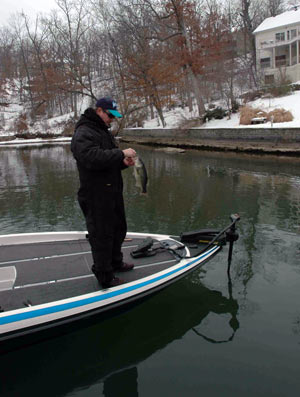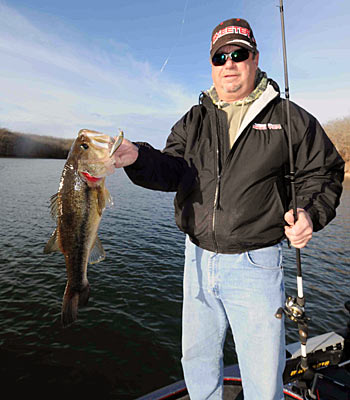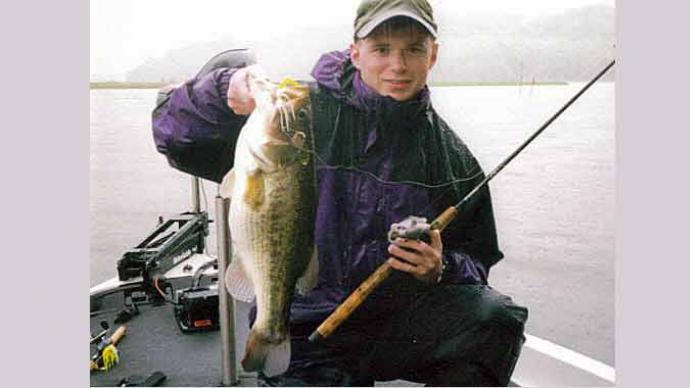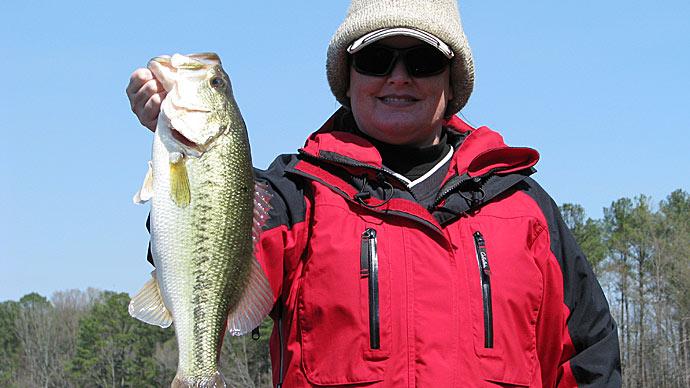
The passage of cold fronts can be a challenging time to catch bass, but Brian Maloney believes this situation negatively affects anglers more than bass.
“You are freezing your tail off and thinking it is killing the fish, but you must remember that those fish are already in winter mode,” Maloney says. “Their metabolism is already shut down. So in the wintertime, don’t get wrapped up in what the front is doing. I think that is more the front messing with the fisherman than it is messing with the fish.”
The former Bass Fishing League All-American champion notices that cold fronts in the spring have a more drastic effect on bass than wintertime cold fronts. “In the springtime, the fish are getting ready to spawn, and all of a sudden, they get hammered with a 30 to 40-degree change of a cold front that screws it all up,” Maloney says.
Bass are already sluggish during the dead of winter when water temperatures plummet into the upper 30s or low 40s, so a cold front that drops air temperatures into the 20-degree range makes little difference to the fish. “I don’t think that hurts the fish as much, but I do believe that they will seek out any source of heat they can find, which might be a good chunk rock bank, slab rocks, and brush piles,” Maloney says. “If the water is clear enough, the brush piles will absorb enough of the UV rays and hold the heat.”
The arrival of a cold front works in your favor because bass will move up more shallow on a rocky bank seeking the warmth of the rocks and taking advantage of the cloud cover to feed. Maloney suggests those bass will remain shallow the morning after the front passes until the sun shines on them.
“If you go two or three days of cloud cover and then all of a sudden slap a bluebird sky on bass, it messes with them,” Maloney says. “I believe as the day goes on with a bright bluebird sky, it kind of messes with the fish’s eyes, and they haven’t adapted to the light yet, so they tend to pull off the bank and sink a little deeper in the brush.”
The former Forrest Wood Cup qualifier still keys on shallower shady areas the first day of sunshine after a cold front but has to move deeper to catch bass the second day after the front. Maloney agrees with the old axiom that fishing is toughest on the second sunny day of a cold front. “We struggle because we do not realize what is going on with the fish, and we are fishing what we had two days before when we had cloud cover,” he says.

Water clarity dictates how deep bass will move after a winter cold front. Maloney suggests bass in off-color water might only drop down 2 feet, but fish on clear-water lakes dive down 15 feet or deeper. On 45-degree rocky banks void of cover, post-frontal winter bass will move away from the rocks and suspend in open water.
Baitfish also leave the bank and head for the middle of coves after a winter cold front. “The baitfish might be 3 to 10 feet deep, maximum, on good days, but on those cold fronts, you will see them push out, and the next thing you know, they are hugging the bottom at 20 feet,” Maloney says.
The Missouri angler throws the same lures during and after a winter cold front. If Maloney has caught bass during a cold front with a suspending stickbait, Alabama rig, or finesse jig along a chunk rock bank, he will continue to throw the same lures after the front in the low light of morning or shady areas. He has to probe deeper water with the Alabama rig or jig when the mid-day sun eliminates the shade option. Maloney claims he has dragged his A-rig 50 to 60 feet deep to catch winter post-frontal bass at Table Rock Lake.
In the middle of winter, Maloney downsizes his suspending stickbaits to 2 1/2- to 3-inch models to catch finicky bass. When the larger gizzard shad start dying in late winter, Maloney opts for bigger stickbaits such as Megabass Vision 110 and 130 models or magnum-size Rattlin’ Rogues. Maloney is a finesse jig fanatic, so he continues to fish his 5/16- and 7/16-ounce finesse jigs throughout all wintertime conditions.
Maloney advises a slow lure presentation is a must during the winter, whether fishing before, during, or after a cold front. “You are already slowed down on your baits,” he says. “The surface temperature tells you to do that regardless of what the sky looks like. If it’s 35 to 40 degrees surface temperature, you should already be going as slowly as possible. So I don’t think you have to change your approach or cadence.”
When a winter cold front hits your favorite bass fishery, bundle up in layers of warm clothing and ignore the cold because bass are still biting.




